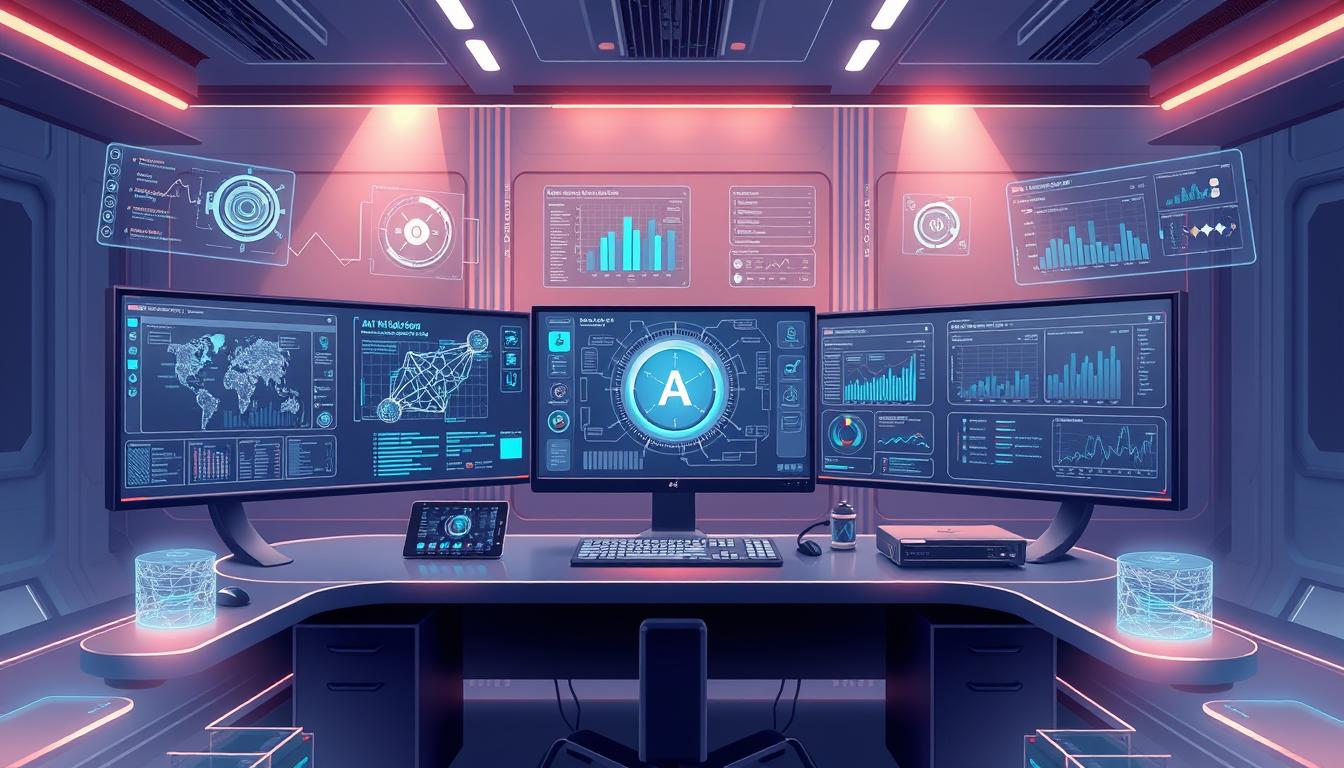Best AI Content Detectors
In today’s digital world, it’s hard to tell if something was written by a human or a machine. This has led to a race in technology, creating AI content detection tools. These tools help check if text is real or made by AI, keeping online info trustworthy.
Tools like Originality.AI, GPTZero, and Winston AI are at the forefront. They can spot AI-written text with great accuracy. For example, TraceGPT claims to be 99.91%-99.93% accurate in finding AI content.
The fight between AI creators and detectors is ongoing. But can these tools keep up with AI’s fast progress? Let’s explore the best AI content detection tools and how they help us in the digital world.
Key Takeaways
- AI content detectors use machine learning to analyze and identify AI-generated text
- Top tools like GPTZero and Copyleaks show high accuracy in distinguishing human from AI-written content
- Accuracy rates vary, with some detectors claiming up to 99% success in identifying AI content
- Many AI detection tools offer free basic plans, making them accessible to various users
- The effectiveness of AI content detectors is crucial for maintaining online information integrity
Understanding AI Content Detection
AI content detection is key in today’s digital world. With more AI-generated text around, we need better ways to spot it. Let’s dive into AI content detectors and why they’re important for keeping content real.
What is an AI content detector?
An AI content detector is a smart tool that finds AI-written text. It uses AI to check text patterns and language. This helps spot content made by computers.
How do AI content detectors work?
These detectors look at text’s complexity and how it changes. They use these factors to guess if it’s AI-made. But, they’re not always right. A test showed they got it wrong over 20% of the time when trying to spot human writing.
Why are AI content detectors important?
AI content detectors are crucial for keeping content real. They stop cheating in school, keep online info trustworthy, and ensure quality content. With tools like ChatGPT getting more popular, these detectors help tell human from AI writing. Yet, even the best ones can make mistakes. For example, OpenAI’s tool got only 26% of AI texts right.
Criteria for Evaluating AI Content Detectors
Choosing the right AI content detector is key for managing content well. You should look at AI detection accuracy, false positives, user interface, and how well it integrates.
AI detection accuracy is very important. Studies show detectors are right 7 out of 10 times on average. But, this can change. For example, Copyleaks claims it’s 99% accurate in spotting AI-generated content.
False positives are a big worry. A study found 10% to 28% of texts written by humans were seen as AI-generated. This shows why picking tools with low false positive rates is crucial.
The user interface is also key for efficiency. A design that’s easy to use lets you analyze content fast, saving time and effort.
Integration capabilities are vital for a smooth workflow. Look for detectors that work well with your current content management systems and other tools.
| Criteria | Importance | Example |
|---|---|---|
| AI Detection Accuracy | High | 70% average reliability |
| False Positives | Critical | 10-28% in human-written texts |
| User Interface | Moderate | Intuitive design for quick analysis |
| Integration Capabilities | Important | Compatibility with CMS and other tools |
By carefully looking at these criteria, you can pick an AI content detector that meets your needs. It will improve your content management process.
Top AI Content Detectors in the Market
The AI content industry has grown fast, especially in content creation. Google’s 2022 update made high-quality content more important. Now, comparing AI detection software is key. Let’s look at some top content authenticity tools and plagiarism checkers.
Originality.AI
Originality.AI is known for its high accuracy. It has over 99% accuracy on the 2.0.1 Standard model and 98% on the 1.0.0 Lite model. It scans websites, detects plagiarism, and supports team work. Its pricing starts at $30 for 3000 credits, with each credit checking 100 words.
GPTZero
GPTZero is easy to use and has a Chrome extension. It’s loved by educators and students for its simplicity.
Content at Scale
Content at Scale offers a free AI detector for creating long-form content. It gives a score from 0% to 100% to show how much of the text is human-written.
Winston AI
Winston AI highlights sentences and gives readability scores. It claims to detect AI-generated text with up to 99.6% accuracy. It has a free basic plan and paid options start at $12 a month for annual plans.
Copyleaks
Copyleaks checks source code and integrates with LMS. It’s great for schools and businesses needing thorough plagiarism detection and AI content identification.
Each tool meets different needs, showing the variety in AI detection and plagiarism checking.
Best AI Content Detectors for Specific Use Cases
AI content detectors are key in many fields. Each industry has its own needs for spotting AI-made content. Let’s look at the top AI detectors for teachers, marketers, and companies.
For educators and academic institutions
Educational AI tools are vital for keeping learning honest. GPTZero is a top pick for fighting plagiarism. It works well with Microsoft Word and Learning Management Systems. Its free version is great for spotting human-written content.
For content marketers and publishers
Content marketing tools must check for AI while keeping up with SEO. Originality.AI is known for its AI detection skills. It’s affordable at $0.01 per credit (for 100 words). It also checks for plagiarism, making it a full package for writers.
For businesses and organizations
Business AI tools need to grow and work well with other systems. Winston AI meets these needs with its Team Plan. It’s 99% accurate in spotting AI text from ChatGPT and GPT-4. It also scans images for text, making it useful for many business tasks.
| Tool | Key Feature | Best For |
|---|---|---|
| GPTZero | LMS Integration | Education |
| Originality.AI | Plagiarism + AI Detection | Content Marketing |
| Winston AI | Team Collaboration | Businesses |
Choosing the right AI content detector depends on your specific needs. Think about accuracy, how well it works with other systems, and cost when deciding.
Features to Look for in AI Content Detectors
When picking AI content detectors, look for a few key features. High accuracy rates are a must. For example, Winston AI can spot AI-generated content with 99% accuracy, including from ChatGPT and GPT-4.
It’s also important to check if the detector can verify text authenticity. Originality.ai is known for its high precision in this area. Don’t forget to look at the pricing. Winston AI starts at $18 a month, while Originality.ai offers a $14.95 monthly plan with credits.
Integration capabilities are also crucial for a smooth workflow. GPTZero, made for educators, works well with Microsoft Word and Learning Management Systems. It even lets you scan AI content in Word or Google documents, saving teachers’ time.
A user-friendly interface makes the detection process easier. GPTZero has a simple design for quick AI content checks. Browser extensions from Originality.AI and Copyleaks also make your toolkit more convenient.
Look for detectors with extra features like plagiarism checking and readability analysis. These tools help ensure your content is original and of high quality.
Limitations and Challenges of AI Content Detection
AI content detectors face big challenges in spotting machine-generated text. They struggle with issues that make them less reliable and effective.
False Positives and Negatives
One big problem is false positives and negatives. AI detectors might say human-written content is AI-made, or miss AI-created text. This leads to mixed results from different tools.
Evolving AI Language Models
AI language models are getting better fast. They now write like humans, making it tough for detectors to keep up. This is a big challenge.
Human-AI Collaboration
More people are working with AI to create content. This makes it harder for detectors to tell what’s human and what’s AI. It’s a big problem.
| Challenge | Impact |
|---|---|
| False Detection Rates | Reduced reliability of AI content detectors |
| Evolving AI Models | Difficulty in keeping detection tools updated |
| Human-AI Collaboration | Blurred lines between human and AI-generated content |
These issues show we need to keep improving AI detection. As content creation changes, so must the tools to check its origins.
How to Use AI Content Detectors Effectively
AI content detectors are powerful tools. But, to use them well, you need to know their strengths and weaknesses. It’s important to follow best practices and use strong content verification strategies.
One key tip is to use multiple detectors for cross-verification. Since most detectors were made based on GPT-2, they might not work well with newer models like GPT-3. Using several tools can give you a more accurate check of your content’s originality.
It’s also key to keep your detection software up to date. AI language models change fast, so using the latest tools is important. Mix automated detection with human review for the best results.
| AI Detection Best Practice | Benefit |
|---|---|
| Use multiple detectors | Improved accuracy |
| Regular software updates | Better detection of new AI models |
| Human review | Catches nuances AI might miss |
| Focus on content quality | Improves overall authenticity |
For content creators, knowing how these detectors work is helpful. It lets you create real content while using AI tools. Write content that’s friendly and conversational to keep readers engaged and avoid being seen as AI-generated.
Remember, AI content detectors are tools to help verify content, not the final say. Use them as part of a bigger plan to make sure your content is high-quality and original.
The Future of AI Content Detection
AI detection advancements are changing how we create and check content. As machine learning grows, we see a battle between AI content and detection tools.
Content authenticity tech is getting smarter. For example, some AI detectors can spot specific AI models in content. This is key for keeping digital communications trustworthy.
Even old documents face AI checks. A test showed the Declaration of Independence was 98.51% AI-made, from 1776. This shows the hurdles current tools face.
Looking ahead, we can expect:
- Blockchain for better content checks
- AI detectors for 15+ languages
- More accurate with false positives under 2%
- APIs for easy workflow use
With tools like ChatGPT and GPT-4 getting popular, we need better detection. The future of AI content detection is about finding a balance. It’s about keeping quality content important, no matter where it comes from.
Conclusion
AI content detection is now key in our digital world. Advanced language models have made it essential to find reliable AI content detectors. Tools like Originality.AI, GPTZero, and Content at Scale help spot AI-generated text. Each tool is designed for different needs.
Choosing the right AI content detector is crucial for keeping content real. For example, Originality.AI is great at finding content from many AI generators. GPTZero is best for detecting ChatGPT text. Content at Scale, with its training on billions of pages, helps a wide range of users.
As AI grows, so does our need to check content. The role of AI content detection is vital, especially with more companies using AI by 2022. By keeping up with AI news and using these tools well, we can deal with AI content. This helps keep human work genuine and valuable.
Source Links
- The best AI content detectors in 2024 | Zapier
- Do AI Detectors Really Work? I Put Them to Test
- What Are the Best AI Detectors?
- What Are AI Content Detectors & How to Bypass AI Content Detection
- How Reliable Are AI Detectors? Claims vs. Reality
- How do AI content detectors work — and can you trust them? – Plus
- 4 Ways AI Content Detectors Work To Spot AI
- Evaluating the efficacy of AI content detection tools in differentiating between human and AI-generated text – International Journal for Educational Integrity
- I tested 7 AI content detectors – they’re getting dramatically better at identifying plagiarism
- 32 Best AI Content Detection Tools Reviewed – Originality.AI
- The 10 Greatest AI Content Detector Tools
- 5+ Best AI Content Detectors for 2024
- 16 of the best AI and ChatGPT content detectors compared
- 9 Best AI Content Detectors in 2024 (Future Proof Your Content)
- Types of AI Detectors You Need to Know | Undetectable AI
- Careful use of AI detectors
- Do AI Content Detectors Work? | Content Whale
- Do Ai Content Detectors Work — The In-Depth Discussion
- AI Content Detectors Don’t Work (The Biggest Mistakes They Have Made)
- Originality AI Plagiarism and Fact Checker – Publish With Integrity
- AI Content 2024: How to Stay Ahead of AI Detection Tools – Stan Ventures
- 8 Most Accurate and Reliable AI Content Detectors in 2023
- 8 of the Best AI Content Detectors Compared







